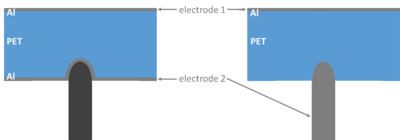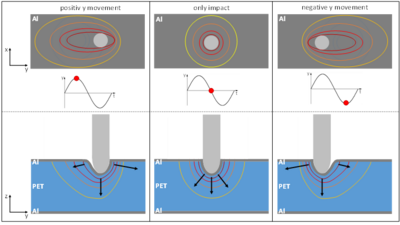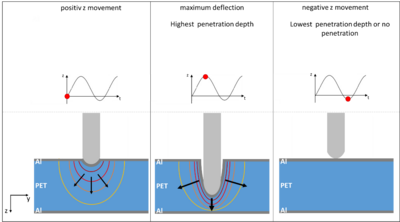Research on the usability of flexoelectricity
A further growing area in research is Sensor technology and Energy Harvesting. Most of the sensor and energy harvesting approaches focus on piezoelectric, thermoelectric or electro-dynamic conversion principles. Another possible conversion principle requiring much further investigations is the flexoelectric effect.
Flexoelectricity defines the change of electrical polarization induced by changing of strain gradients in dielectric materials [1]. In contradiction to the piezoelectric effect, show all dielectric materials a felexoelectric behavior [2]. This can lead to a wide range of applications in new technical Energy Harvesting solutions from the perspective of a wide variety of insulating materials.
In our investigation we induced mechanical strain gradients by needles of steel. These Needles pressed into a polyethylene terephthalate (PET) polymer film to generated the strain. A first electrode configuration use two surface electrodes on both sides (Figure 1 left) of the polymer film and a second uses only one surface electrode and the impacting needles as opposite electrode (Figure 1 right) [3].
The movement of the film horizontally (Figure 2) or vertically (Figure 3) to the needle tips lead to a change of mechanical strain gradients. Since changes in polarization lead to a variation of the voltage and capacitance of the samples, the flexoelectric effect can be verified in this way [4].
The voltage was measured by a Lock-In Amplifier and the capacitance was measured by an Impedanz Analyzer. An electrostatic approximation was done to distinguish flexoelectric from electrostatic energy conversion. The results show a change of the voltage and capacitance following the mechanical input (Figure 4).
It is much higher as it could be only caused by an electrostatic conversion. This indicates clearly the existence of another polarization effect - the flexoelectric effect. A deeper understanding of the effect could open new energy conversion possibilities with many dielectric materials.
References
[1] Tagantsev, A.K.; Yudin, P. V. “Flexoelectricity in solids – From Theory to Application”; World Scientific Publishing Co. Pte. Ltd., 2017
[2] Resta, R.; “Towards a Bulk Theory of Flexoelectricity”; Physical Review Letters 105 (12), 2010
[3] Seyfert, L.; Moritz, L.; Ben Ammar, H.; Schwesinger, N.; "Verification of the flexoelectric effect in PET polymer films for EH applications"; SPIE Proceedings Volume 11376, Active and Passive Smart Structures and Integrated Systems XIV, 2020
[4] Seyfert, L.; Henneberg, A.; Schwesinger, N.; „Possibilities of using flexoelectric effect for energy harvesting applications“; SPIE Proceedings Volume 10967, Active and Passive Smart Structures and Integrated Systems XIII, 2019



